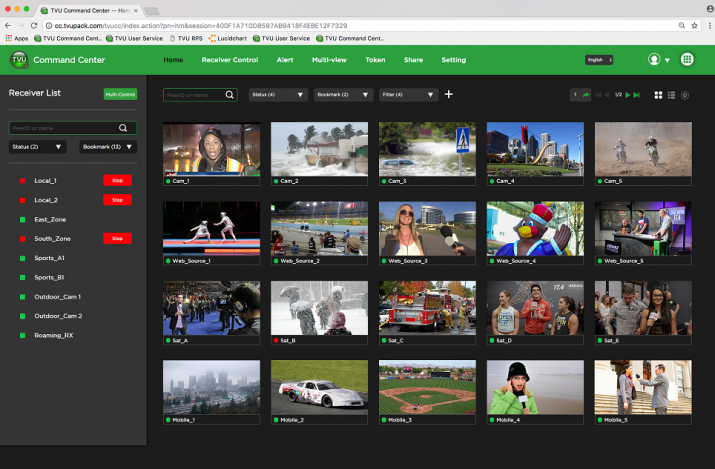NAB 2018: Panasonic,TVU Networks To Display New Camera/IP Management, Delivery Integration
With a new integration of Panasonic cameras, TVU Networks and Panasonic further their technology collaboration with the introduction of two new video solutions. With these new product integrations, TVU welcomes Panasonic to the TVU ecosystem and TVU Grid featuring IP video switching, routing and distribution. The Panasonic/TVU integrations will be on display during NAB 2018.
 “Panasonic has always been a leader in video acquisition, and we’re thrilled to showcase its P2 cameras working seamlessly with our IP-based management and distribution technology at NAB this year,” says Paul Shen, CEO, TVU Networks. “It’s a prime example of creating an easier workflow for our customers, and we’re eager for them to see how easy and powerful the Panasonic/TVU combination is for them. No matter their location, they can acquire and transmit live, low-latency, HD video over IP, and distribute the video with TVU Grid to multiple outlets. In addition, the integration provides an entry into the TVU Grid ecosystem and a part of the largest global video distribution network with over 2500 broadcast stations.”
“Panasonic has always been a leader in video acquisition, and we’re thrilled to showcase its P2 cameras working seamlessly with our IP-based management and distribution technology at NAB this year,” says Paul Shen, CEO, TVU Networks. “It’s a prime example of creating an easier workflow for our customers, and we’re eager for them to see how easy and powerful the Panasonic/TVU combination is for them. No matter their location, they can acquire and transmit live, low-latency, HD video over IP, and distribute the video with TVU Grid to multiple outlets. In addition, the integration provides an entry into the TVU Grid ecosystem and a part of the largest global video distribution network with over 2500 broadcast stations.”
The Panasonic AJ-PX270 is a handheld HD camcorder that combines the high quality and efficiency of low bit-rate AVC-ULTRA recording and the flexibility of a 3G/4G/LTE wireless mobility. The integration between Panasonic AJ-PX270 P2 cameras and TVU Transceivers enables streaming from a P2 camera directly to a TVU Transceiver via cellular, WiFi or ethernet connection.
“We’re excited to expand our collaboration with TVU Networks to further accelerate remote production workflows and increase quality and efficiency,” says Delix Joseph T. Alex, product manager, of PTZ Camera & IP Networking Systems at Panasonic. “The new integrations allow for centralization of AVC-ULTRA P2 cameras along-side AW Series PTZ cameras for a very elegant and scalable network video production system, all configurable from anywhere in the world connected to the internet.”
Each Panasonic camera has a unique network ID that communicates to the TVU Transceiver or TVU Command Center, a cloud-based management and control system. The camera provides an IP video stream, thumbnail and status to the Transceiver or Command Center. In addition, a live stream from the Panasonic P2 camera can be triggered, monitored and managed on the TVU Transceiver or TVU Command Center interface. Received P2 streams can then be distributed to other locations via TVU Grid.
TVU Grid is a scalable IP-based video switching, routing and distribution solution that enables broadcasters to acquire live video from different sources for distribution to other Grid-enabled locations. It is also possible to utilize P2 camera sources with the suite of functions available on the TVU Transceiver or the TVU Cloud service including IP streaming output (direct to Facebook Live, Periscope and other social media services), TVU Producer Pro, TVU Booking Service and more.
In a separate integration between the two companies, Panasonic’s pan/tilt/zoom (PTZ) cameras such as the AW-HE130 can also be paired with TVU Vista, a routing device which provides for the streaming, management and control of IP-based PTZ cameras from remote locations. Ideal for fixed camera deployment such as traffic cameras and beauty shot cameras, Vista aggregates multiple IP connections simultaneously for high bandwidth such as cellular, WiFi, Ethernet, satellite and other IP connections. It also uses TVU’s patented Inverse Statmux + (IS+) technology for stable and resilient transmission over the public Internet.
TVU Vista allows the Panasonic PTZ camera to stream directly from the field back to the studio for decoding and processing using a TVU Transceiver. Once received at the TVU Transceiver, the PTZ camera stream can be distributed via TVU Grid to other locations or streamed to the web using the camera’s IP streaming output or used as a source for Cloud production or Social Media using TVU Producer Pro. Remote camera control for pan, tilt and zoom can easily be done back in the studio using the camera’s own control interface.
